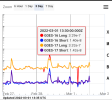You are using an out of date browser. It may not display this or other websites correctly.
You should upgrade or use an alternative browser.
You should upgrade or use an alternative browser.
Sol (Sun) and its phenomena
- Thread starter mabar
- Start date
A minor C5.1 flare off the east limb at 21:40 UTC (Feb 25)
Sun spots number increase
According to Solar Influences Data Analysis Center (SIDC) sunspot number has increased to 55
Solar flare class 3
Scientists classify solar flares according to their X-ray brightness, in the wavelength range 1 to 8 Angstroms. Flares classes have names: A, B, C, M, and X, with A being the tiniest and X being the largest. Each category has nine subdivisions ranging from, e.g., C1 to C9, M1 to M9, and X1 to X9.
Solar flare class 3
Scientists classify solar flares according to their X-ray brightness, in the wavelength range 1 to 8 Angstroms. Flares classes have names: A, B, C, M, and X, with A being the tiniest and X being the largest. Each category has nine subdivisions ranging from, e.g., C1 to C9, M1 to M9, and X1 to X9.
Sunspots increased to 64.

Geostationary Operational Environmental Satellites (GOES) are used to track solar activity and solar flares. Large solar X-ray flares can change the Earth’s ionosphere, which blocks high-frequency (HF) radio transmissions on the sunlit side of the Earth. Solar flares are also associated with Coronal Mass Ejections (CMEs) which can ultimately lead to geomagnetic storms. SWPC sends out space weather alerts at the M5 (5x10-5 Watts/mw) level. Some large flares are accompanied by strong radio bursts that may interfere with other radio frequencies and cause problems for satellite communication and radio navigation (GPS).

I would ask, is Nemesis out there?
